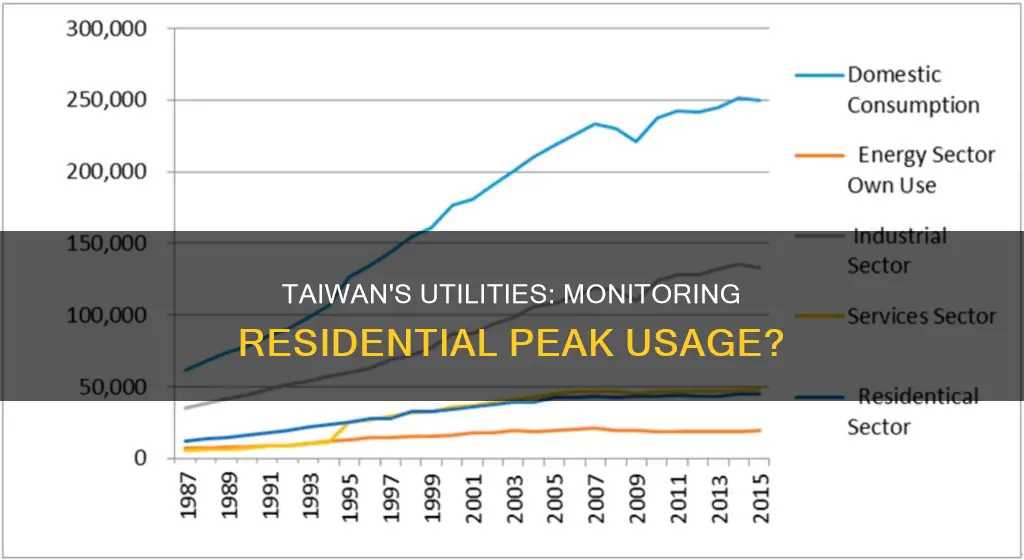
Taiwan's electricity sector is regulated by the state-owned Taiwan Power Company (Taipower), which supplies electricity to Taiwan and nearby locations. Taipower has been working to meet the ever-growing demand for electricity in Taiwan, which has a densely populated and highly industrialised economy. The company has a detailed transition plan, which includes a commitment to invest approximately US$14 billion in renewable energy between 2015 and 2030. This includes a target of 82% smart electricity management coverage and the installation of smart meters in 6 million households by 2030. This will enable its demand-side management services, which helped reduce the daily peak demand in 2018 by 3.93 GW. Taipower also uses a five-point colour scale to indicate the level of electricity reserve, with green indicating a reserve margin of more than 10% of total power generation and black indicating a margin of less than 500 MW, which initiates electricity rationing.
What You'll Learn

How is Taiwan's electricity sector structured?
Taiwan's electricity sector is regulated by the state-owned Taiwan Power Company (Taipower), which was established on May 1, 1946. Taipower is headquartered in Taiwan and has approximately 27,000 employees, supplying electricity to Taiwan and nearby locations.
Taipower's revenue in 2019 was US$19.89 billion, with an installed capacity of 33.16 GW. The company has been shifting its focus from coal and nuclear power to increased gas and renewable energy sources. In 2018, Taipower's renewable energy capacity was 2.11 GW (6.4% of total capacity), with plans to expand to 3.05 GW by 2025 and 5.4 GW by 2030. This shift is supported by investments totalling approximately US$14 billion between 2015 and 2030.
Taipower operates three types of power plants based on generation characteristics: peaking power plants, load-following power plants, and base load power plants. As of 2007, Taiwan had a total of 78 power plants, including 39 hydropower plants, 27 thermal power plants, 9 wind farms, and 3 nuclear power plants.
The Taichung Power Plant in Longjing District, Taichung, is the world's fourth-largest coal-fired power plant, with a 5,500 MW installed capacity. Taiwan also has the world's largest combined cycle gas turbine power plant, the Tatan Power Plant in Guanyin, Taoyuan, with a capacity of 4,419 MW.
In terms of electricity generation, Taiwan relies heavily on fossil fuels, with 79.6% of its electricity coming from natural gas, coal, oil, and cogeneration in 2022. Nuclear power accounts for 9.1%, while renewable energy sources, including hydro, contribute the remaining 11.3%.
The liberalization of Taiwan's electricity market in 1995 introduced independent power producers, and there are currently nine such producers in Taiwan. Taipower purchases electricity from these independent producers, contributing to Taiwan's annual growth in electricity generation.
Inns and Internet Privacy: What You Need to Know
You may want to see also

How does residential energy usage in Taiwan compare to the US?
Taiwan's energy sector is regulated by the state-owned electric power utility company Taiwan Power Company (Taipower). Taipower supplies electricity to Taiwan and nearby locations and has around 27,000 employees.
In 2022, 79.6% of Taiwan's electricity generation came from fossil fuels (43.4% natural gas, 34.8% coal, 3.8% oil, 1.4% cogeneration, and 1.2% from hydro). The remaining electricity was generated from nuclear power (9.1%) and renewable energy sources (8.6%).
In comparison, the US energy sector is largely privatised. In 2020, the US generated around 38% of its electricity from natural gas, 19% from nuclear power, 11% from coal, and 19% from renewable energy sources.
Taiwan's energy consumption per capita is significantly higher than the Asian average. In 2022, Taiwan's total consumption per capita was 4.9 toe, compared to the Asian average of 1.6 toe. Similarly, Taiwan's electricity consumption per capita was 11,078 kWh, compared to the Asian average of 3,700 kWh.
Taiwan has taken steps to reduce its energy consumption and increase the use of renewable energy sources. The country has set a target of achieving 20% of its electricity generation from renewable sources by 2025 and has invested in the development of solar, wind, and geothermal energy.
The US has also made efforts to increase the use of renewable energy sources and has set a goal of achieving a carbon pollution-free power sector by 2035. In 2021, renewable energy sources accounted for 20% of the US's total electricity generation.
Monitoring Data Usage on iPhone: Tips and Tricks
You may want to see also

How does Taiwan's energy consumption vary throughout the year?
Taiwan's energy consumption varies throughout the year, with some sources indicating an overall upward trend in energy consumption, while others suggest a more fluctuating pattern. Here is an analysis of how Taiwan's energy consumption changes over time:
Historical Perspective
Taiwan's energy consumption has generally increased over the past decade. From 2012 to 2021, total energy consumption grew almost every year, peaking at 248.81 TWh in 2021. This growth can be attributed to various factors, including economic development, population increase, and changing energy sources.
Seasonal and Monthly Variations
While data on monthly or seasonal variations is limited, it can be inferred that energy consumption in Taiwan follows a similar pattern to many countries, with higher consumption during winter months due to increased heating demands and lower consumption in milder seasons.
Fuel Type Breakdown
The breakdown of energy consumption by fuel type offers insight into the variability throughout the year. Here is the fuel type breakdown for a few recent years:
- 2022: Fossil fuels accounted for 79.6% of energy generation (43.4% natural gas, 34.8% coal, and the remaining from other sources like oil and cogeneration). Nuclear energy contributed 9.1%, renewables 8.6%, and hydro 1.2%.
- 2020: Coal dominated with 45% of energy generation, followed by natural gas (35.7%), nuclear (11.2%), and renewables (5.4%).
- 2018: Oil was the primary energy source at 48.28%, followed by coal (29.38%), natural gas (15.18%), nuclear energy (5.38%), biomass and waste (1.13%), and other renewable sources (0.64%).
Impact of Policy Changes
Taiwan's energy consumption variability is also influenced by policy changes and initiatives. The country has actively promoted energy efficiency and set ambitious targets, such as a 33% energy efficiency goal by 2025. Additionally, the government is encouraging the development of clean energy sources like solar, wind, and biofuels, aiming for renewable energy to comprise 15%-20% of the energy mix by 2025. These initiatives impact energy consumption patterns and contribute to a more sustainable energy future for Taiwan.
Monitoring Power Usage: Simple Steps for Your Home
You may want to see also

What is the impact of weather on Taiwan's energy usage?
Taiwan's energy usage is impacted by the weather in several ways. Firstly, the country experiences frequent blackouts due to malfunctions in feedlines and transformers, which are often caused by centralized and aging infrastructure. These issues can be exacerbated by extreme weather events, such as storms, which can damage power lines and disrupt the electricity supply. For example, the largest power outage in Taiwan's history occurred in August 2015 when Typhoon Soudelor hit the island, leaving 4.85 million households without electricity.
Secondly, Taiwan's energy usage is closely linked to its manufacturing industry, particularly the semiconductor industry, which consumes a significant amount of electricity. During periods of hot weather, the increased use of air conditioning can put a strain on the electricity grid and lead to power rationing. For example, in October 2016, the Taiwanese government ordered government offices to reduce power usage, especially air conditioning and lights, due to the reduced reserve capacity caused by the hot weather.
Thirdly, Taiwan's energy usage is also impacted by the weather through its reliance on renewable energy sources, such as solar and wind power. These sources are intermittent and dependent on weather conditions, with sunlight and wind availability fluctuating throughout the year. Taiwan has been promoting the use of renewable energy and aims to have renewables account for 20% of its energy mix by 2025. However, the country still relies heavily on fossil fuels, with coal and natural gas representing 81.5% of total electricity generation in 2021.
Overall, the impact of weather on Taiwan's energy usage is significant. The country needs to continue investing in grid upgrades and energy storage systems to improve its resilience to weather-related disruptions and increase the stability of its electricity supply.
Monitoring Power Usage: A Comprehensive Guide to Energy Efficiency
You may want to see also

How does Taiwan's energy consumption compare to other countries?
Taiwan's energy consumption is high compared to other countries in Asia. In 2022, the country's total energy consumption per capita was 4.9 toe, which is three times higher than the Asian average of 1.6 toe. Similarly, Taiwan's electricity consumption per capita is three times higher than the regional average at 11,078 kWh.
In 2022, Taiwan's electricity generation was heavily reliant on fossil fuels, with natural gas and coal accounting for 43.4% and 34.8% of the total, respectively. Together with oil, cogeneration, and other sources, fossil fuels made up 79.6% of Taiwan's electricity generation. This is significantly higher than the global average, with fossil fuels responsible for around three-quarters of electricity generation worldwide.
Taiwan's energy consumption has been changing in recent years. Between 2018 and 2020, total consumption decreased by 2.2% per year on average. However, in 2021, it increased by 4.3%, and in 2023, it decreased again by 4.5%. The energy intensity of Taiwan's GDP is also decreasing rapidly, with a 3.2% annual decline since 2010.
In terms of renewable energy, Taiwan has set targets to increase its capacity. The "Renewable Energy Development Act" aims for renewables to make up 20% of the capacity mix by 2025, with investments estimated at US$56.6 billion. Taiwan also submitted its own NDC (Nationally Determined Contribution) to decrease net greenhouse gas emissions by 50% by 2030 compared to a business-as-usual projection, with a further updated target of a 25% reduction by 2023.
Monitoring Wi-Fi Usage on iPhone: A Step-by-Step Guide
You may want to see also
Frequently asked questions
Yes, Taiwan Power Company (Taipower) is a state-owned utility company that monitors and supplies electricity to Taiwan and nearby locations.
Taipower operates three types of power plants: peaking power plants, load-following power plants, and base load power plants. They also implement a five-point colour scale to indicate the level of electricity reserve, with green indicating a reserve margin of more than 10%, and black indicating a margin of less than 500 MW, initiating electricity rationing.
Taipower has set targets to reduce emissions intensity by 20% by 2030 compared to a 2016 baseline. They are also investing in renewable energy sources, aiming for 3.05 GW by 2025 and 5.4 GW by 2030.







